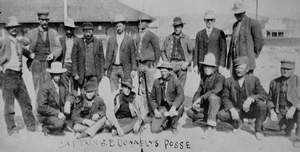| Battle of Kelley Creek | |||||||
|---|---|---|---|---|---|---|---|
| Part of the American Indian Wars | |||||||
 The posse of J.P. Donnelley. | |||||||
| |||||||
| Belligerents | |||||||
|
| Daggett's Shoshone band | ||||||
| Commanders and leaders | |||||||
|
| Mike Daggett | ||||||
| Casualties and losses | |||||||
| 1 killed |
8 killed, including 2 children 4* surviving children captured and arrested | ||||||
| |||||||
Location of Kelley Creek, Nevada | |||||||

The Battle of Kelley Creek, also known as the Last Massacre, is often considered to be one of the last known massacres carried out between Native Americans and forces of the United States, and was a closing event to occur near the end of the American Indian warfare era.[2] In January 1911 a small band of Shoshones[3] were accused of rustling cattle and then killing four stockmen who went to investigate the dead cattle. A posse of policemen and citizens was sent to track the band, who were found encamped near Winnemucca, Nevada, in a region known as Kelley Creek. A largely one-sided battle ensued on February 25 that ended with the direct deaths of nine people, eight Daggetts and one posse member. At the time the affair was briefly characterized as a Native American revolt, though it is now mostly regarded as a family's attempted escape from law enforcement.[4]
- ^ "Kelly Creek (historical), alternate name: Kelley Creek". Geographic Names Information System. United States Geological Survey, United States Department of the Interior.
- ^ Mullen Jr., Frank X. (February 19, 2011). "Shoshone Mike: New theories emerge 100 years after 'last massacre' (part 1)". Reno Gazette-Journal. Retrieved April 22, 2020.
- ^ Bergon, Frank (December 1, 1987). "Shaping the Past: The search for Shoshone Mike". Vassar Quarterly. LXXXIV (1): 16–19. Retrieved April 27, 2021.
- ^ Dorr, Susanna. "Last Indian Uprising?". www.gbcnv.edu. Retrieved 2018-05-30.
© MMXXIII Rich X Search. We shall prevail. All rights reserved. Rich X Search


